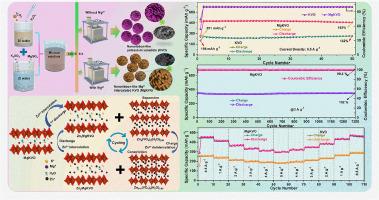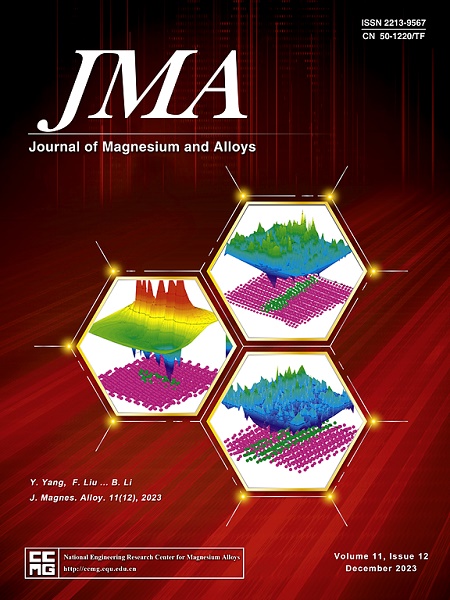通过预叠层 Mg2+ 对钒酸钾阴极进行结构改造,实现高性能和耐用的可充电水性锌离子电池
IF 13.8
1区 材料科学
Q1 METALLURGY & METALLURGICAL ENGINEERING
引用次数: 0
摘要
锌(Zn)离子水电池(AZIBs)具有成本低、环保、安全和能量密度高的特点,有望用于大规模储能。大量研究集中于提高 AZIB 的性能,但挑战依然存在。钒基氧化物以其较大的层间间距而著称,是很有前途的阴极材料。在本报告中,我们通过一步水热法合成了掺杂 Mg2+ 的钒酸钾(KVO)(MgKVO),并实现了 12.2 Å 的层间距。Mg2+ 的插层增强了 KVO 的性能,为 Zn2+ 提供了宽阔的通道,从而实现了高容量和离子扩散。K+ 和 Mg2+ 插层的共同作用增强了 MgKVO 的导电性。这种结构设计赋予了 MgKVO 优异的电化学性能。采用 MgKVO 阴极的 AZIB 在 0.5 A g-1 电流条件下具有 457 mAh g-1 的高容量,在 5 A g-1 电流条件下具有 298 mAh g-1 的优异速率性能,在 3 A g-1 电流条件下循环 1300 次以上具有 102% 的出色循环稳定性。此外,伪电容分析表明了 MgKVO 的高电容贡献率和 Zn2+ 扩散系数。值得注意的是,原位 X 射线衍射、X 射线光电子能谱和拉曼分析进一步证明了电池系统循环过程中发生的 Zn2+ 插入/萃取和 Zn 离子存储机制。这项研究为钒氧化物中的双阳离子插层提供了新的见解,并为设计高容量 AZIB 的阴极提供了新的解决方案。本文章由计算机程序翻译,如有差异,请以英文原文为准。


Structural engineering of potassium vanadate cathode by pre-intercalated Mg2+ for high-performance and durable rechargeable aqueous zinc-ion batteries
Aqueous zinc (Zn)-ion batteries (AZIBs) have the potential to be used in massive energy storage owing to their low cost, eco-friendliness, safety, and good energy density. Significant research has been focused on enhancing the performance of AZIBs, but challenges persist. Vanadium-based oxides, known for their large interlayer spacing, are promising cathode materials. In this report, we synthesize Mg2+-intercalated potassium vanadate (KVO) (MgKVO) via a single-step hydrothermal method and achieve a 12.2 Å interlayer spacing. Mg2+ intercalation enhances the KVO performance, providing wide channels for Zn2+, which results in high capacity and ion diffusion. The combined action of K+ and Mg2+ intercalation enhances the electrical conductivity of MgKVO. This structural design endows MgKVO with excellent electrochemical performance. The AZIB with the MgKVO cathode delivers a high capacity of 457 mAh g-1 at 0.5 A g-1, excellent rate performance of 298 mAh g-1 at 5 A g-1, and outstanding cycling stability of 102% over 1300 cycles at 3 A g-1. Additionally, pseudocapacitance analysis reveals the high capacitance contribution and Zn2+ diffusion coefficient of MgKVO. Notably, ex-situ X-ray diffraction, X-ray photoelectron spectroscopy, and Raman analyses further demonstrate the Zn2+ insertion/extraction and Zn-ion storage mechanisms that occurred during cycling in the battery system. This study provides new insights into the intercalation of dual cations in vanadium oxides and offers new solutions for designing cathodes for high-capacity AZIBs.
求助全文
通过发布文献求助,成功后即可免费获取论文全文。
去求助
来源期刊

Journal of Magnesium and Alloys
Engineering-Mechanics of Materials
CiteScore
20.20
自引率
14.80%
发文量
52
审稿时长
59 days
期刊介绍:
The Journal of Magnesium and Alloys serves as a global platform for both theoretical and experimental studies in magnesium science and engineering. It welcomes submissions investigating various scientific and engineering factors impacting the metallurgy, processing, microstructure, properties, and applications of magnesium and alloys. The journal covers all aspects of magnesium and alloy research, including raw materials, alloy casting, extrusion and deformation, corrosion and surface treatment, joining and machining, simulation and modeling, microstructure evolution and mechanical properties, new alloy development, magnesium-based composites, bio-materials and energy materials, applications, and recycling.
 求助内容:
求助内容: 应助结果提醒方式:
应助结果提醒方式:


